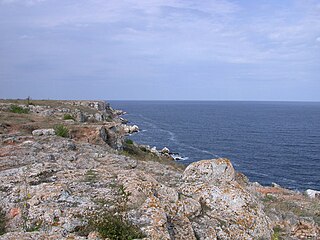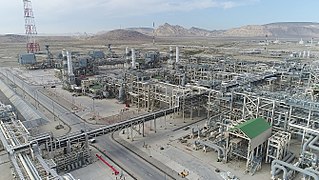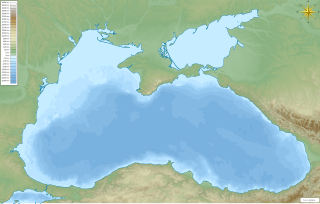
North Sea oil is a mixture of hydrocarbons, comprising liquid petroleum and natural gas, produced from petroleum reservoirs beneath the North Sea.

The Statfjord oil field is an enormous oil and gas field covering 580 km2 in the U.K.-Norwegian boundary of the North Sea at a water depth of 145 m, discovered in 1974 by Mobil and since 1987 operated by Statoil.

Gullfaks is an oil and gas field in the Norwegian sector of the North Sea operated by Statoil. It was discovered in 1978, in block 34/10, at a water depth of 130-230 meters. The initial recoverable reserve is 2.1 billion barrels, and the remaining recoverable reserve in 2004 is 234 million barrels. This oil field reached peak production in 2001 at 180,000 barrels per day (29,000 m3/d). It has satellite fields Gullfaks South, Rimfaks, Skinfaks and Gullveig.

Azeri–Chirag–Gunashli or Azeri–Chirag–Deepwater Gunashli is a complex of oil fields in the Caspian Sea, about 120 kilometres (75 mi) off the coast of Azerbaijan. It consist of Azeri and Chirag oil fields, and the deepwater portion of the Gunashli oil field. An overall estimated area of the development is 432.4 square kilometres (167.0 sq mi). It is developed by the Azerbaijan International Operating Company, a consortium of international oil companies, and operated by BP on behalf of the consortium. The ACG fields have estimated recoverable reserves of about 5 to 6 billion barrels of petroleum. As of the end of 2005, the production rate from eight pre-drilled wells at the platform was approximately 240,000 barrels per day (38,000 m3/d).
Türkiye Petrolleri Anonim Ortaklığı (TPAO) was founded in 1954 by Law No. 6327 with the responsibility of being involved in hydrocarbon exploration, drilling, production, refinery and marketing activities as Turkey's national company.

Tyulenovo is a village and seaside resort on the north Bulgarian Black Sea Coast, part of Shabla Municipality, Dobrich Province.

The Sangachal Terminal is an industrial complex consisting of a natural gas processing plant and oil production plant, located on the coast of the Caspian Sea 45 kilometres (28 mi) south of Baku, Azerbaijan.

JKX Oil & Gas plc is a British-based hydrocarbon exploration and production company, listed on the London Stock Exchange. JKX operates primarily in Russia and Ukraine, but has a presence in six other countries in Europe and North America. In June 2011, VTB Capital plc, a subsidiary of Russian state bank VTB, increased its share in JKX Oil & Gas to 6.4%. The deal makes VTB bank the fourth largest shareholder in the company. Ihor Kolomoyskyi, the co-owner of Privat Group, remains the largest shareholder in JKX with a 27.06% stake.

Grane is an offshore oil field in the North Sea located 185 km (115 mi) west of the city of Haugesund on the western coast of Norway. It is Norway's first heavy crude oil production field and Statoil's largest heavy oil field in the Norwegian continental shelf. The oil from the field, located in Block 25/11 is transported to Sture terminal via Grane oil pipeline. The injection gas is imported to Grane oil field from the Heimdal, located just north the field.

Vale is an offshore gas field in the North Sea located 16 kilometres (9.9 mi) north of the Heimdal gas field. The depth of the water in the field area is 115 metres (377 ft). Vale is considered a satellite to Heimdal field and is connected to it by a pipeline. Estimated reserves at Vale stand at 2.5 billion cubic metres of natural gas and 21 million barrels (3,300,000 m3) of gas condensate. Vale gas field is expected to produce 1.6 million cubic metres per day of natural gas and 2,600 barrels per day (410 m3/d) of condensate.
The Lebăda Vest oil field is an oil field located on the continental shelf of the Black Sea. It was discovered in 1980 and developed by Petrom. It began production in 1993 and produces oil. The total proven reserves of the Lebăda Vest oil field are around 50 million barrels (6.8×106tonnes), and production is centered on 10,000 barrels per day (1,600 m3/d). The field also produces around 35.8 million cubic feet/day (1×105m³) of gas and has reserves of 200 billion cubic feet (5.7×109m³).
The Pescăruș oil field is an oil field located on the continental shelf of the Black Sea. It was discovered in 1999 and developed by Petrom. It began production in 2001 and produces oil. The total proven reserves of the Pescăruș oil field are around 100 million barrels (14×106tonnes), and production is centered on 5,000 barrels per day (790 m3/d). The field also produces around 17.9 million cubic feet/day (0.5×105m³) of gas and has reserves of 114 billion cubic feet (3.2×109m³).
The Lebăda Est oil field is an oil field located on the continental shelf of the Black Sea. It was discovered in 1987 and developed by Petrom. It began production in 1989 and produces oil. The total proven reserves of the Lebăda Est oil field are around 50 million barrels (6.8×106tonnes), and production is centered on 15,000 barrels per day (2,400 m3/d). The field also produces around 53.5 million cubic feet/day (1.5×105m³) of gas and has reserves of 242 billion cubic feet (6.9×109m³).
The Sinoe oil field is an oil field located on the continental shelf of the Black Sea. It was discovered in 1991 and developed by Petrom. It began production in 1999 and produces oil. The total proven reserves of the Sinoe oil field are around 20 million barrels (2.7×106tonnes), and production is centered on 3,000 barrels per day (480 m3/d). The field also produces around 10.7 million cubic feet/day (0.3×105m³) of gas and has reserves of 71 billion cubic feet (2×109m³).
The Subbotinske field is a Ukrainian oil field that was discovered in 2009 and located on the continental shelf of the Black Sea. It will begin production in 2015 and will produce oil and natural gas. The total proven reserves of the Subbotinske field are around 732 million barrels (116,400,000 m3), and production will be centered on 50,000 barrels per day (7,900 m3/d).
The Val Shatsky oil field is a Russian oil field that was discovered in 2007 and located on the continental shelf of the Black Sea. It will begin production in 2018 and will produce oil and natural gas. The total proven reserves of the Val Shatsky oil field are around 6.32 billion barrels (860×106tonnes), and production will be centered on 390,000 barrels per day (62,000 m3/d).
The Prykerchenske field is a Ukrainian oil field that was discovered in 2009 and located on the continental shelf of the Black Sea. It will begin production in 2015 and will produce oil and natural gas. The total proven reserves of the Prykerchensky oil field are around 608 million barrels (96,700,000 m3), and production will be centered on 50,000 barrels per day (7,900 m3/d).
The Olimpiysky field is a Romanian oil field that was discovered in 2001 and located on the continental shelf of the Black Sea. It will begin production in 2016 and will produce oil and natural gas. The total proven reserves of the Olimpiysky oil field are around 70 million barrels (11,000,000 m3), and production will be centered on 5,000 barrels per day (790 m3/d) in 2016.
The Midia South East field is a Romanian oil field that was discovered in 2001 and located on the continental shelf of the Black Sea. It will begin production in 2020 and will produce oil and natural gas. The total proven reserves of the Midia South East oil field are around 750 million barrels (119,000,000 m3), and production will be centered on 50,000 barrels per day (7,900 m3/d) in 2020.
The Anastasievsko-Troitskoye field is a Russian oil field that was discovered in 1994 and located on the continental shelf of the Black Sea. It began production in 1995 and produces oil and natural gas. The total proven reserves of the Anastasievsko-Troitskoye oil field are around 190 million barrels (30,000,000 m3), and production is centered on 12,000 barrels per day (1,900 m3/d) in 2013.









